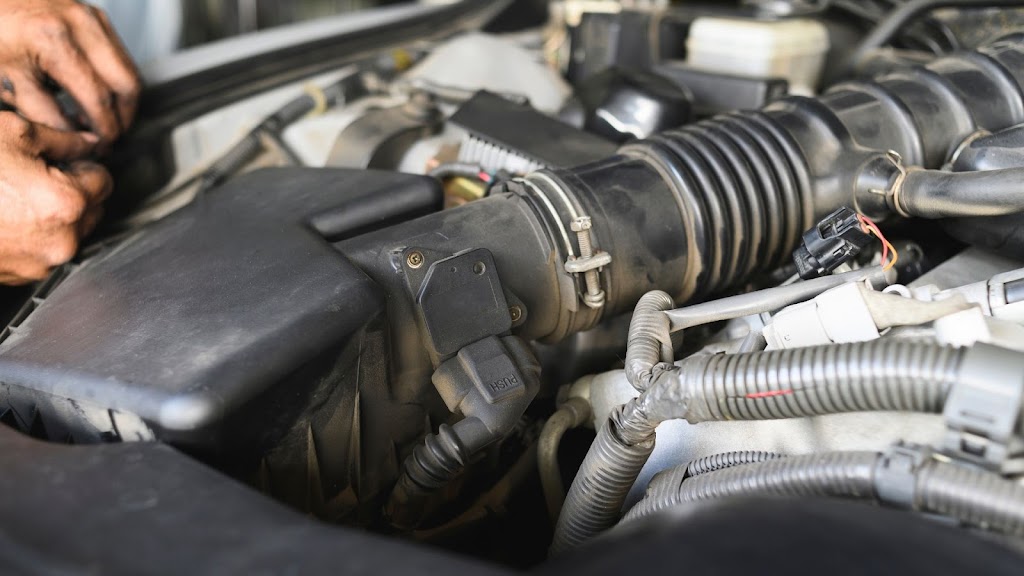The Mass Airflow Sensor (MAF) is a crucial component in a car’s engine system. It measures the amount of air entering the engine and provides this information to the engine control unit (ECU). Understanding the role of the MAF is important for car owners and enthusiasts as it directly affects the engine’s performance and overall efficiency. By understanding how the MAF works and recognizing common symptoms of a faulty MAF, car owners can take appropriate measures to maintain and replace this vital component.
Understanding the Role of the Mass Airflow Sensor (MAF)
The Mass Airflow Sensor (MAF) is a sensor that measures the amount of air entering the engine. It is typically located between the air filter and the intake manifold. The MAF works by using a heated wire or film element that is cooled by the incoming air. As more air flows over the element, it cools down further, and this change in temperature is measured by the sensor. The MAF then sends this information to the ECU, which uses it to calculate the correct amount of fuel to inject into the engine.
The MAF plays a crucial role in the engine’s performance as it directly affects the air-fuel mixture ratio. If the MAF is not functioning properly, it can lead to an incorrect calculation of fuel injection, resulting in poor engine performance, decreased fuel efficiency, and increased emissions. Therefore, it is important to ensure that the MAF is in good working condition to maintain optimal engine performance.
Common Symptoms of a Faulty MAF
A faulty MAF can manifest itself in various ways, and it is important to recognize these symptoms to diagnose and address the issue promptly. Some common symptoms of a faulty MAF include rough idling, stalling, poor acceleration, and the illumination of the check engine light.
Rough idling occurs when the engine runs unevenly or vibrates excessively when at idle. This can be caused by an incorrect air-fuel mixture due to a faulty MAF. Stalling is another symptom that can occur when the MAF is not providing accurate readings to the ECU, resulting in an incorrect fuel injection calculation. Poor acceleration is often experienced when the MAF is not functioning properly, as the engine is not receiving the correct amount of air and fuel for optimal combustion. Finally, the check engine light may illuminate when there is a problem with the MAF, indicating that the ECU has detected an issue with the sensor.
Why Your Car Runs Worse with a New MAF
It may seem counterintuitive, but sometimes a car can run worse after installing a new MAF sensor. There are several possible reasons for this issue. One reason could be that the new MAF sensor is not compatible with the car’s make and model. Different cars require different types of MAF sensors, and using an incompatible sensor can lead to incorrect readings and poor engine performance.
Another reason could be that the new MAF sensor is faulty or of poor quality. It is important to choose a reputable brand and ensure that the sensor is of high quality to avoid any issues. Additionally, improper installation of the new MAF sensor can also cause the car to run worse. It is important to follow the proper installation procedure and avoid common mistakes to ensure that the sensor is functioning correctly.
To fix the problem of a car running worse with a new MAF sensor, it is important to first ensure that the sensor is compatible with the car’s make and model. If it is not, it may be necessary to replace it with the correct sensor. If the sensor is compatible, but still causing issues, it may be necessary to check for any wiring issues or other engine problems that could be affecting the MAF sensor’s performance.
Possible Causes of MAF-Related Issues
There are several possible causes of MAF-related issues. One common cause is a dirty or damaged MAF sensor. Over time, the MAF sensor can become dirty due to the accumulation of dust, dirt, and oil particles from the air. This can affect the sensor’s ability to accurately measure the airflow, leading to incorrect readings and poor engine performance. Additionally, the MAF sensor can become damaged due to physical impact or exposure to extreme temperatures, which can also affect its performance.
Another possible cause of MAF-related issues is wiring issues. The MAF sensor is connected to the ECU through a wiring harness, and any issues with the wiring can affect the sensor’s ability to send accurate readings to the ECU. This can result in poor engine performance and other related symptoms.
Other engine problems can also affect the performance of the MAF sensor. For example, a vacuum leak can cause an incorrect reading from the MAF sensor, leading to poor engine performance. It is important to address any other engine problems that may be affecting the MAF sensor’s performance to ensure optimal engine performance.
How to Diagnose MAF Problems
Diagnosing MAF problems can be done using a step-by-step approach. The first step is to connect a diagnostic scanner to the car’s OBD-II port and check for any trouble codes related to the MAF sensor. If there are any trouble codes present, it can help narrow down the issue and guide further diagnosis.
Next, it is important to visually inspect the MAF sensor for any signs of damage or dirt buildup. If the sensor appears dirty, it may be necessary to clean it. However, it is important to note that cleaning the MAF sensor should be done carefully and using the appropriate cleaning solution to avoid damaging the delicate components.
If visual inspection does not reveal any issues, it may be necessary to perform a voltage test on the MAF sensor. This involves using a multimeter to measure the voltage output of the sensor while the engine is running. The voltage readings should be within the specified range for the particular make and model of the car. If the readings are outside of the specified range, it may indicate a problem with the MAF sensor.
Tips for Proper MAF Installation
Proper installation of the MAF sensor is crucial to ensure its optimal performance. Before installing a new MAF sensor, it is important to perform some pre-installation checks. This includes checking the compatibility of the sensor with the car’s make and model, as well as ensuring that the sensor is of high quality and from a reputable brand.
During the installation process, it is important to follow the proper procedure outlined in the car’s service manual. This may involve removing the air filter housing, disconnecting the wiring harness, and removing the old MAF sensor. The new MAF sensor should then be installed in the reverse order, ensuring that all connections are secure and properly tightened.
There are some common mistakes to avoid during the installation process. One common mistake is not properly aligning the MAF sensor with the air intake tube. This can result in air leaks and poor engine performance. Another common mistake is not properly connecting the wiring harness, which can lead to electrical issues and incorrect readings from the MAF sensor.
How to Clean a Dirty MAF Sensor
Cleaning a dirty MAF sensor is an important maintenance task that can help improve engine performance. It is important to clean the MAF sensor carefully to avoid damaging its delicate components. Before cleaning the MAF sensor, it is important to gather the necessary tools, including a cleaning solution specifically designed for MAF sensors, a soft brush or cloth, and a can of compressed air.
To clean the MAF sensor, start by disconnecting the wiring harness and removing the sensor from its housing. Gently spray the cleaning solution onto the sensor, making sure to cover all areas. Use a soft brush or cloth to gently remove any dirt or debris from the sensor. Avoid using any abrasive materials that could damage the sensor.
Once the sensor is clean, use a can of compressed air to blow away any remaining dirt or debris. Allow the sensor to air dry completely before reinstalling it. It is important to follow the proper installation procedure to ensure that the sensor is securely and correctly installed.
When to Replace Your MAF Sensor
There are several signs that indicate the need for MAF sensor replacement. One common sign is a persistent check engine light. If the check engine light continues to illuminate even after cleaning or diagnosing the MAF sensor, it may indicate that the sensor is faulty and needs to be replaced.
Another sign is a significant decrease in engine performance and fuel efficiency. If the car is experiencing poor acceleration, rough idling, or stalling, and these issues persist even after cleaning or diagnosing the MAF sensor, it may be necessary to replace it.
Additionally, if the MAF sensor is physically damaged or shows signs of wear and tear, it may be necessary to replace it. Physical damage can affect the sensor’s ability to accurately measure airflow and provide correct readings to the ECU.
Choosing the Right MAF Sensor for Your Car
When choosing a replacement MAF sensor for your car, there are several factors to consider. First, it is important to ensure that the sensor is compatible with your car’s make and model. Different cars require different types of MAF sensors, and using an incompatible sensor can lead to poor engine performance and other related issues.
It is also important to choose a reputable brand and ensure that the sensor is of high quality. A high-quality sensor will provide accurate readings and last longer, ensuring optimal engine performance.
Additionally, it may be helpful to consult with a trusted mechanic or refer to the car’s service manual for guidance on choosing the right MAF sensor. They can provide valuable insights and recommendations based on their experience and knowledge.
Other Factors that Affect Your Car’s Performance
While the MAF sensor plays a crucial role in a car’s performance, it is important to note that there are other factors that can also affect engine performance. Regular maintenance is essential to keep the engine running smoothly. This includes regular oil changes, air filter replacements, and spark plug replacements.
Other components that can affect engine performance include the fuel injectors, ignition system, and exhaust system. It is important to address any issues with these components promptly to ensure optimal engine performance.
Conclusion
Understanding the role of the Mass Airflow Sensor (MAF) is important for car owners and enthusiasts. The MAF plays a crucial role in the engine’s performance by measuring the amount of air entering the engine and providing this information to the ECU. Recognizing common symptoms of a faulty MAF and knowing how to diagnose and address MAF-related issues is essential for maintaining optimal engine performance.
Proper MAF installation, regular maintenance, and choosing the right replacement MAF sensor are important steps in ensuring the longevity and efficiency of your car’s engine. By taking these steps and addressing any issues promptly, car owners can enjoy a smooth and reliable driving experience.

